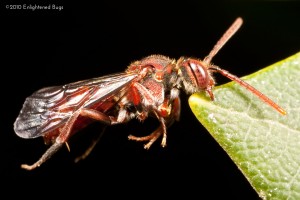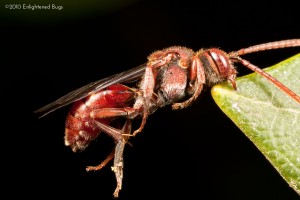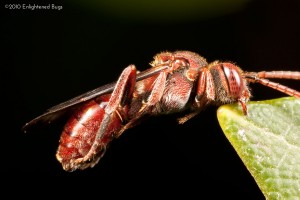Some bees may sleep in a flower, but other bees simply desire a somewhat sheltered place above the ground, without relying on a flower’s amenities (pollen, nectar, self-closing petal doors!)
This solitary cuckoo bee is a case in point. I took this series of photos over the course of several minutes last April (there being no bees here just yet… even heavy snow just last week!) After clamping its mandibles onto that particular rhododendron leaf, the bee began an extensive self-cleaning process. Those mandibles are powerful indeed… enough to suspend the bee easily from the rhododendron leaf, freeing it to move all six legs and both wings easily at any angles to aid in cleaning.
It spent the night there without hiccup… I visited in the morning, and the bee was still clamped in position, body sticking straight out parallel to the ground, suspended seemingly weightlessly by its mandibles. An odd way to sleep, but it looks as though it works well! So now I look for bees clamped to leaves under “awnings” of other leaves, as well as bees tucked away inside flowers overnight :)




 A closed flower is the perfect spot… a place to sleep, nectar to drink, pollen to enjoy… what could be better for a bee?
A closed flower is the perfect spot… a place to sleep, nectar to drink, pollen to enjoy… what could be better for a bee? This bumble bee was one of at least fifty or so small bumble bees covering a purple aster (a bush about four feet tall all round, one itself of four or five others with similarly large clouds of these same small bumble bees).
This bumble bee was one of at least fifty or so small bumble bees covering a purple aster (a bush about four feet tall all round, one itself of four or five others with similarly large clouds of these same small bumble bees).